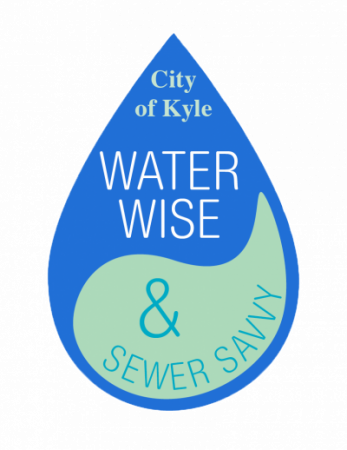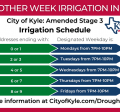Water Wise & Sewer Savvy
We want to help our citizens be informed, knowledgeable and to make good decisions about how they participate in the use of our water resources and the needs of responsible sewer operations.
Water Wise
In Texas, we have seen considerable population growth over the last decade. One of the most important, if not the most important, resource involved with that growth is water. That's the Water Wise part of the program. The City of Kyle has several sources of water, which when managed properly give us a sustainable and reliable drinking water supply. Management however is a team effort, every resident, visitor and indeed business can help us use our water resources wisely.
Indoors
- Shower to save water. A bath typically uses up to 50 gallons of water, whereas a five-minute shower will use only 10-25 gallons depending on the efficiency of your showerhead.
- Keep drinking water in the refrigerator instead of letting the water run until cool. A running faucet can use about two gallons of water per minute.
- Turn off water while you brush your teeth. You can save as much as four gallons of water by simply turning off the water when you brush your teeth. If you brush your teeth in the morning and at night, that adds up to saving 200 gallons of water a month. The same is true when you wash your hands or shave.
- Wash only full loads of clothes. Older top-loading machines use 40 gallons of water to wash a full load. Today’s newer standard models use 27 gallons, and more efficient ENERGY STAR washers use 14 gallons of water per wash.
- Pick the appropriate water level setting – often small, medium, large – for the load if that’s how your washing machine works. Front loaders and most high-efficiency top loaders have auto-load sensing, and a few of the latest agitator top-loaders have it, too.
- Verify that your home is leak-free. Make sure to check and repair leaks, broken lines, watering fixtures, and irrigation systems.
- Check your toilet for leaks by adding food coloring to the tank. If the toilet is leaking, color will appear in the bowl within 15 minutes. (Flush as soon as the test is done, since food coloring may stain the tank.) A leaky toilet can waste 200 gallons of water per day.
- Repair dripping faucets and showers. If your faucet is dripping at the rate of one drop per second, you can waste over 3,000 gallons of water per year.
Outdoors
- Never leave a garden hose running. A running hose can use up to 600 gallons of water in just a few hours. Keep a positive shut-off nozzle on all outdoor hoses.
- Don’t use a hose to spray away debris. Clean your sidewalk or driveway with a broom instead and save up to 80 gallons of water.
- Cover your spa or pool to reduce evaporation. An average size pool left uncovered can lose as much as 1,000 gallons of water per month.
- Stop that drip. Check for leaks in outdoor faucets, pipes and hoses.
- Water your lawn and garden early in the morning or in the evening and never on a windy day. This will avoid water loss to evaporation when the sun is at its highest. Using a sprinkler that sprays large droplets rather than a fine mist will also reduce loss of water due to evaporation. Make sure to follow current drought restrictions for watering days/times.
- Water your lawn and garden, not the driveway. Adjust your sprinkler so water is aimed directly at plants rather than the house, sidewalk, driveway or street.
- Only water when your lawn is thirsty. Overwatering promotes shallow root growth making your lawn less hardy. One simple way to tell if your grass needs water is to step on it. If it springs back, there is ample moisture. If it lies flat, it needs water. Watering your lawn deeply instead of frequent, shallow watering encourages deep root formation which will help your lawn be more resistant to drought and disease.
- Mulch, mulch, mulch! This is one of the most important aspects of keeping the water you apply to your plants in the soil instead of evaporating into the air! Mulching also reduces weed growth and weeds competing with your plants for water. You can use woodchips, pine straw, shredded newspaper or many other types of materials.
- Don’t mow too close. Maintain a lawn height of three to four inches to help protect the roots from heat stress and reduce the loss of moisture to evaporation.
- Plan your landscape. Cluster plants with similar water requirements together. Designate zones for areas requiring frequent watering, occasional watering and no watering. Match plants to yard conditions such as sunny, shady, dry or damp.
For more information on using water wisely go to the EPA’s WaterSense website.
Sewer Savvy
The Sewer Savvy part of the program is aimed at educating residential customers on things that should never go down the sewer from their homes and commercial customers on things they should never put down the drain from their place of business.
As far as toilets go, three is a magic number. The only three things that really should ever be flushed down the toilet are urine, fecal matter, and toilet paper.
Items you should NOT flush or pour down the drain:
- “Flushable” wipes. These fibrous wipes plug up pumps and create huge fibrous masses in lift stations that can lead to overflows and environmental impact which can cost tax-payers tens of thousands of dollars each year.
- Kleenex, paper towels, and tissue paper. They may seem like they’re in the same family as toilet paper, but they take a lot longer to break down in the sewer system and cause sewage blockages.
- Unused drugs or pharmaceuticals
- Tampons and Sanitary Napkins
- Disposable Diapers
- Fats and Oils
- Fertilizers, pesticides, insecticides or herbicides
- Automotive chemicals
- Paint
For more information about what you should/shouldn't flush or pour down the drain, visit the Down the Drain Guide
Learn more about disposing of household hazardous waste in Hays County.







